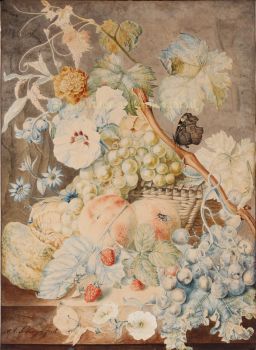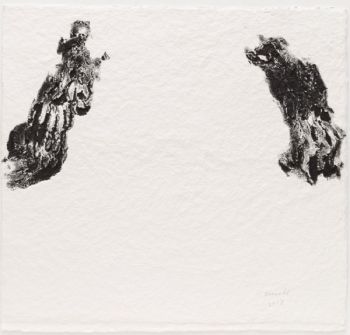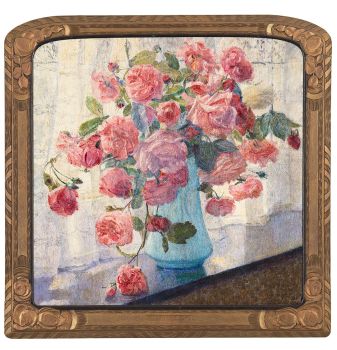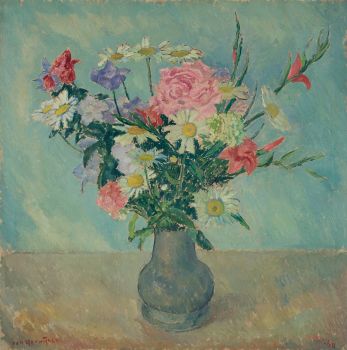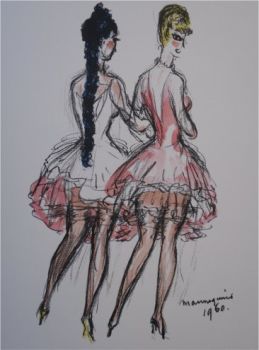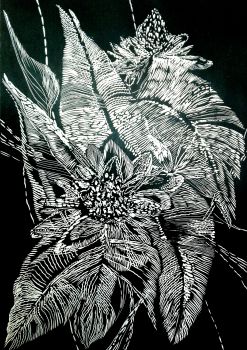Rose 1799
Gerard van Spaendonck
Paper
50 ⨯ 33 cm
€ 1.250
Inter-Antiquariaat Mefferdt & De Jonge
- About the artworkRose a cent feuilles [rose with one hundred petalls) or cabbage rose, stippel engraving made by P.F. le Grand after a drawing by Gerard(us) van Spaendonck from the Fleurs dessinées d'après nature, published between 1799 and 1801. With original hand colouring. Size. (print) approx. 50 x 33 cm. The Centifolia roses date from around 1550. Although once regarded as forms of a species, they are now thought most likely to be hybrids between the autumn damask and an alba rose. Centifolias are usually compact bushes with heavy double flowers which often droop under there own weight. The colours varied from white to deep rose red plus striped and spotted varieties. They were much featured in the paintings of the Dutch masters and came to be known as "The rose of the painters". It has fragrant, mid pink, double flowers, the buds of which are covered in fine tubercles or filaments known as moss. Mosses are natural mutations which first occurred on Damask and Centifolia roses. They were very fashionable in the early eighteenth and nineteenth centuries when several hundred forms were raised. Gerard van Spaendonck (1756-1842) studied with decorative painter Willem Jacob Herreyns in Antwerp. In 1769 he moved to Paris, where in 1774 he was appointed miniature painter in the court of Louis XVI. In 1780 he succeeded Madeleine Françoise Basseporte as professor of floral painting at the Jardin des Plantes, and was elected a member of the Académie des beaux-arts shortly afterwards. Van Spaendonck contributed to over fifty works of Les Vélins du Roi, a famous collection of botanical watercolours owned by French royalty. From 1799 to 1801 he published twenty-four plates as part of his Fleurs Dessinees d'apres Nature (Flowers Drawn from Life), which were high-quality engravings for students of floral painting. Today the Fleurs Dessinees d'apres Nature are considered among the best botanical engravings in the world. Stipple engravings with which one is able to differentiate between different tones of gray, turned out to be highly suitable for depicting botanical details, a method that Van Spaendonck also taught his pupil Pierre-Joseph Redouté. Like other famous flower painters, Van Spaendonck was also technically perfect: in oil, watercolour, pen or pencil, on any scale. With attention to every minute detail and elegance and sophistication of the composition, he shows his mastery. Like Jan van Huysum, Van Spaendonck understood the zeitgeist and created flower compositions that matched the taste of the public of around 1800. He combined the traditional Dutch way of representing flowers with French sophistication and good taste. Price: Euro 1.250,-
- About the artist
Gerard was an older brother of Cornelis van Spaendonck (1756-1840), who was also a well-known painter. In the years 1760-1769 he studied in Antwerp with the decorative painter Willem Herreyns. In 1769 he moved to Paris, and in 1774, through the mediation of Claude-Henri Watelet, at the age of 28, he was appointed miniature painter at the court of Louis XVI. He exhibited for the first time in 1777. In 1780 he succeeded Françoise Basseporte (1701-1780) as professor of flower painting at the Jardin des Plantes. Shortly afterwards he was elected a member of the Académie des beaux-arts.
Van Spaendonck painted in both oil and watercolor. He made more than fifty works for the Vélins du Roi, a renowned collection of botanical watercolors owned by the French royal family. From 1799 to 1801 he published 24 plates of his Fleurs Dessinées d'après Nature (Flowers drawn from life); high quality engravings for flower painting students. Today Fleurs dessinées d'après nature is a highly regarded book in the field of flower painting.
In 1788 Van Spaendonck was appointed advisor to the Académie, and in 1795 he was one of the founders of the Institut de France. In 1804 he was awarded the Legion of Honour. Shortly afterwards he was ennobled by Napoleon Bonaparte. Van Spaendonck died in 1822 at the age of 76.
At Groeseindstraat 99 in Tilburg, a plaque can be seen where the birthplace of the Van Spaendonck brothers used to be. Besides painter Karel Appel, Gerard van Spaendonck is the only Dutchman to be buried at Père Lachaise in Paris. Gerard is right behind Chopin's grave.
Are you interested in buying this artwork?
Artwork details
Related artworks
- 1 - 1 / 1
Artista Desconocido
A large wall map of Asia by Nicolas de Fer 1647 - 1720
Precio a consultarZebregs & Röell - Fine Art - Antiques
1 - 4 / 24- 1 - 4 / 24
Thea G.F. Eschauzier
Retrato de una niña javanesa1931
Precio a consultarZebregs & Röell - Fine Art - Antiques
Cornelis Anthonisz Theunissen
MUY RARO PRIMER MAPA IMPRESO DE ÁMSTERDAM, UNA CIUDAD EN ASCENSO1544
€ 175.000Inter-Antiquariaat Mefferdt & De Jonge
 curada por
curada porDanny Bree
André Lanskoy
Composition Abstraite (sur fond noir)20th century
Precio a consultarFrans Jacobs Fine Art
1 - 4 / 24- 1 - 4 / 12






